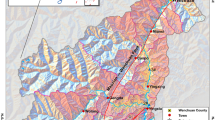Abstract
Rainfall in rainy seasons continuously occurs and it is hard to separate individual events which is a significant source for the design of drainage facility to reduce Combined Sewer Overflows (CSOs). The current design of drainage facilities is based on the maximum design for rainfall events despite its extensive use in urban areas. The design of drainage facility requires the characteristics of rainfall such as average annual rainfall volume, duration and intensity. The individual rainfall events in a continuous rainfall event can be divided by Inter-event Time Definition (IETD). Current techniques for the determination of IETD are autocorrelation analysis, the coefficient of variation analysis, and average annual number of rainfall events analysis. The problem of the existing three methods for IETD is an ambiguous result for the decision. The new method for the determination of IETD using exponential function is suggested. The probability density function of the continuous rainfall event is compared with the confidence range of regression curve generated from the exponential functions at each inter-event time. The comparison of current and new method for the determination of IETD is conducted in the target watershed.
Similar content being viewed by others
References
Adams, B. J. and Papa, F. (2000). Urban Storm water Management Planning with Analytical Probabilistic Models. John Wiley and Sons, New York, NY.
Bedient, P. B. and Huber, W. C. (1988). Hydrology and floodplain analysis, Addison-Wesley, Reading, Mass.
Eagleson, P. S. (1972). “Dynamics of flood frequency.” Water Resources Research, Vol. 8, No. 4, pp. 878–898, DOI: 10.1029/WR008i004p00878.
Guo, Y. and Adams, B. J. (1998a). “Hydrologic analysis of urban catchments with event-based probabilistic models: 1. Runoff volume.” Water Resources Research, Vol. 34, No. 12, pp. 3421–3431, DOI: 10.1029/98WR02449.
Guo, Y. and Adams, B. J. (1998b). “Hydrologic analysis of urban catchments with event-based probabilistic models: 2. Peak discharge rate.” Water Resources Research, Vol. 34, No. 12, pp. 3433–3443, DOI: 10.1029/98WR02448.
Heaney, J. P., Huber, W. C., Medina Jr, M. A., Murphy, M. P., Nix, S. J., and Hasan, S. M. (1977). Nationwide Assessment of Combined Sewer Overflows and Urban Storm water Discharges: Vol. II, Cost Assessment, EPA-600/2-77-064, US Environmental Protection Agency, Cincinnati, OH., United Stutes.
Howard, C. D. (1976). “Theory of storage and treatment-plant overflows.” Journal of the Environmental Engineering Division, Vol. 102, No. 4, pp. 709–722.
James, W. (1994). Current practices in modelling the management of storm water impacts, Lewis Publishers, Boca Raton, Florida, CRC Press.
Joo, J., Lee, J., Kim, J. H., Jun, H., and Jo, D. (2013). “Inter-event time definition setting procedure for urban drainage systems.” Water, Vol. 6, No. 1, pp. 45–58, DOI: 10.3390/w6010045.
Kim, M. S. (2004). Determination of Storage Volume for the Best Management of Non-point Source Pollutants in Urban Area, Master Thesis, Korea University, Korea.
Korea Precipitation Frequency Data Server. Available online: https://doi.org/www.k-idf.re.kr (accessed on 27 November 2017).
Kwon, J. H. (2004). Rainfall Analysis to Estimate the Amount of Nonpoint Source Pollution, Master Thesis, Korea University, Korea.
Li, J. Y. (1991). Comprehensive Urban Runoff Control Planning, Ph.D. Dissertation, Department of Civil Engineering, University of Toronto, Toronto, Ontario.
Nix, S. J. (1994). Urban storm water modeling and simulation, CRC Press/Lewis Publishers, Boca Raton, FL, United Stutes.
Restrepo-Posada, P. J. and Eagleson, P. S. (1982). “Identification of independent rainstorms.” Journal of Hydrology, Vol. 55, No. 1, pp. 303–319, DOI: 10.1016/0022-1694(82)90136-6.
Segarra-García, R. and Loganathan, V. G. (1992). “Storm-water detention storage design under random pollutant loading.” Journal of Water Resources Planning and Management, Vol. 118, No. 5, pp. 475–491, DOI: 10.1061/(ASCE)0733-9496(1992)118:5(475).
United States Environmental Protection Agency. (1986). Methodology for analysis of detention basins for control of urban runoff quality, U.S. Environmental Protection Agency Office of Water, Nonpoint Source Branch, pp. 51, United Stutes.
Author information
Authors and Affiliations
Corresponding author
Rights and permissions
About this article
Cite this article
Lee, E.H., Kim, J.H. Development of New Inter-Event Time Definition Technique in Urban Areas. KSCE J Civ Eng 22, 3764–3771 (2018). https://doi.org/10.1007/s12205-018-1120-5
Received:
Revised:
Accepted:
Published:
Issue Date:
DOI: https://doi.org/10.1007/s12205-018-1120-5




